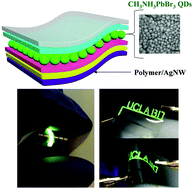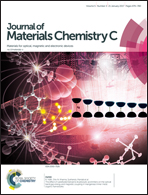Highly flexible organometal halide perovskite quantum dot based light-emitting diodes on a silver nanowire–polymer composite electrode†
Abstract
Organometal halide perovskite light-emitting diodes (LEDs) have witnessed rapid development in a short time span due to the promising electronic and optical properties of perovskite materials, which showed great potential in flexible display devices due to their ease of integration in fabrication process flows. However, simply integrating perovskite films with flexible electrodes for highly flexible LEDs has encountered obstacles, as traditionally used perovskite films show unrecoverable micrometer-sized cracks after bending. Herein, we report on highly flexible LEDs by utilizing silver nanowire based polymer electrodes as anodes, and CH3NH3PbBr3 quantum dots as the emissive layer. The resulting devices are highly flexible and mechanically robust, capable of being bent to a 2.5 mm radius and capable of undergoing 1000 cycles of repeated bending and unbending to a radius of 4 mm without discernible performance degradation. Moreover, these flexible LEDs also exhibit high performance metrics, due in part to efficient charge balance through hole-injection enhancement, with a current efficiency of 10.4 cd A−1, a luminous efficacy of 8.1 lm W−1, and an external quantum efficiency of 2.6% at a brightness of 1000 cd m−2.



 Please wait while we load your content...
Please wait while we load your content...